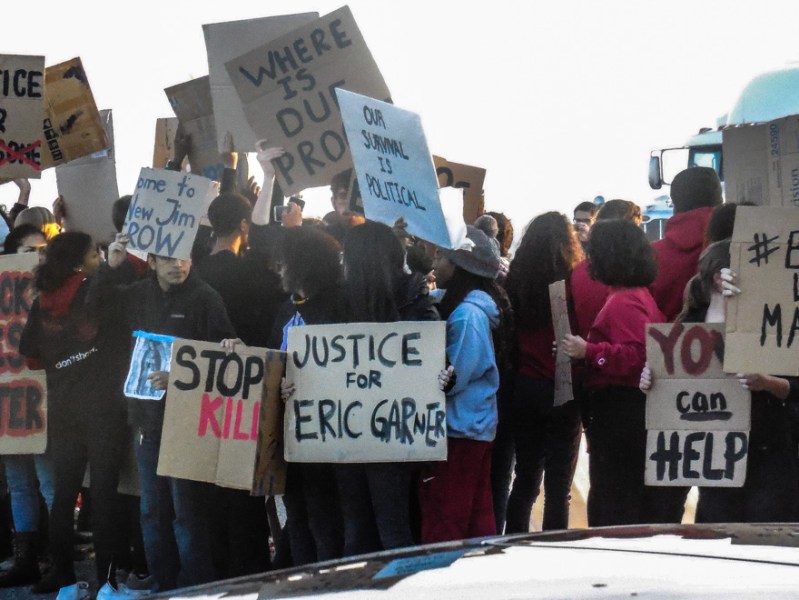More details have emerged in the aftermath of last week’s protest on the San Mateo Bridge.
According to the California Highway Patrol (CHP), there were several traffic accidents related to the demonstration, some of which involved property damage and minor injuries.
San Mateo County District Attorney Stephen Wagstaffe said that his office had not yet decided whether to file charges in the case, but that if charges were filed they would be infractions or misdemeanors rather than felonies.
Separately, participants in the bridge protest have criticized the CHP’s conduct during the protest.
The CHP had been called to respond to one hit-and-run accident related to the protest, according to CHP spokesman Daniel Hill. Officers responding to the protest had also helped several people who were in minor accidents.
The injury in question was a complaint of pain and declined to receive medical attention, and Hill said that reports were not filed in the accidents other than the hit-and-run. Hill said that the demonstrators were largely peaceful.
Hill added that the CHP respects the right to demonstrate but that that pedestrians were not allowed on freeways.
“We respect the public’s right to freely assemble and demonstrate and speak your cause,” Hill said. “Unfortunately the freeway is no place to do that…just for the sheer fact that it’s not a safe place to be a pedestrian.”
Wagstaffe said that the harm the demonstrators caused could be taken into account when his office decided whether or not to file charges.
“We’re going to assess whether or not there was some social impact that calls for a consequence or not,” Wagstaffe said.
He noted that in the past protesters had disrupted a meeting of the San Mateo Board of Supervisors and his office did not file charges because his office thought the level of harm did not merit prosecution. The appearance dates for the protesters are set to be at the end of February and the beginning of March.
Wagstaffe said that “no felonies are involved” in the possible charges his office could file and that based on what he had heard, none of the potential charges would involve the possibility of deportation for international students involved in the demonstration.
The motive for the demonstration would not be taken into account when deciding whether or not to file charges.
“There’s always a million reasons for people to protest and I never assess if one’s good versus the other,” Wagstaffe said.
One participant in the bridge protest, Kristian Davis Bailey ’14, accused the CHP of violating protocols.
“[W]e weren’t given a clear option to disperse,” Bailey said. He added that demonstrators tried to leave the demonstration but were not able to do so.
In an email, Hill said that no dispersal order was required at the demonstration because “[a]s [the protesters] presence on the bridge was already unlawful, there is no legal requirement for an order to disperse to be given prior to making arrests.”
Bailey also expressed concern about what he said were incidents where female demonstrators were patted down by male officers contrary to the wishes of the demonstrators.
In his email, Hill said that it is CHP policy to have female officers pat down female arrestees when possible, but if a female officer is not available female arrestees may be searched by male officers. Hill said that it was possible the protesters on the San Mateo Bridge were searched by male officers and “[t]his is not considered improper or unusual, as all CHP officers, regardless of the officer’s gender, perform searches pursuant to our protocol and policy.”
Bailey said that no new charges had been communicated to the protesters related to the reported traffic accidents. According to him, all of the demonstrators arrested were being represented by a team of four lawyers who specialize in cases of mass civil disobedience.
The demonstrators had received considerable support from the Stanford community and that Stanford affiliates had sent more than 75 emails to the protesters offering support of various kinds, according to Bailey.
“It’s been really amazing to see the outpouring of support from the Stanford community over the past few days,” Bailey said.
Manny Thompson ’15, another protester, justified the interruption of people’s evening commute by saying that people needed to be made aware of the alleged ongoing extrajudicial deaths of black people. Thompson said he had not heard of any new charges connected to the traffic accidents.
According to him, organizers had considered the possibility of arrests prior to the demonstration, but there was not a dedicated “bail fund” created ahead of time.
Stanford disciplinary action would require a formal concern before any action could begin.
Jamie Pontius-Hogan, the deputy director of Stanford’s Office of Community Standards, said in an email that “[o]ur office has not received a formal concern” about the protests.
Contact Caleb Smith at caleb17 ‘at’ stanford.edu.
